
Written by Ross Locksley on 04 Nov 2025
The UK Anime Network turns 30 this year. I could just as easily saved that declaration for next year, as UK Anime (as it was originally called) started life in the walled garden of Compuserve as a simple online blog. It wasn't until 1996 that it was moved to a .nu domain and became globally available, but the blog (not even a word at the time) was the genesis and original code for what became The UK Anime Network, so 1995 it is.
I wanted to document how this site affected my life and worldview, as such I'll stick to my direct experiences without mentioning others by name unless unavoidable - in many cases our paths have long since diverged and regardless, I can't speak for how the site affected them. As for me, the site has played a massive part in my life - it gave me a passion and focus in my teenage years, broadened my cultural perspective, learn and practice the skills that formed the foundation of my companies, make new friends across the world and even, through the technical achievements the site allowed me to develop, semi-retire in my early 40's, giving me time with my daughter I'd never have if working full time. In short, I owe anime, manga and the talents behind them a great deal of gratitude for the life I have today.
My love of anime and manga actually stretches back a little further than UKA's inception, to 1992. Visiting my Mum in hospital, I chanced on a nearby comic shop and found Ranma 1/2, printed in comic format by Viz. The black and white art, pretty girls, martial arts and Japanese culture hooked me instantly - it was fantasy set in a completely foreign culture. For a 13 year-old, the impact was immense. The boobs probably helped, let's be honest.
At the same time as I was messing with HTML, I started a fanzine called The Oriental Express which was first published in early 1996. Written while at college, I was forced to retreat to the internet as a publishing medium when a not-too-happy lecturer discovered how much ink and paper I was using from the common coding room. So all my efforts and enthusiasm moved to the web - by which time Microsoft Frontpage allowed for WYSIWYG coding and I was able to merge my love of graphic print design to a digital format and publish without limitation.
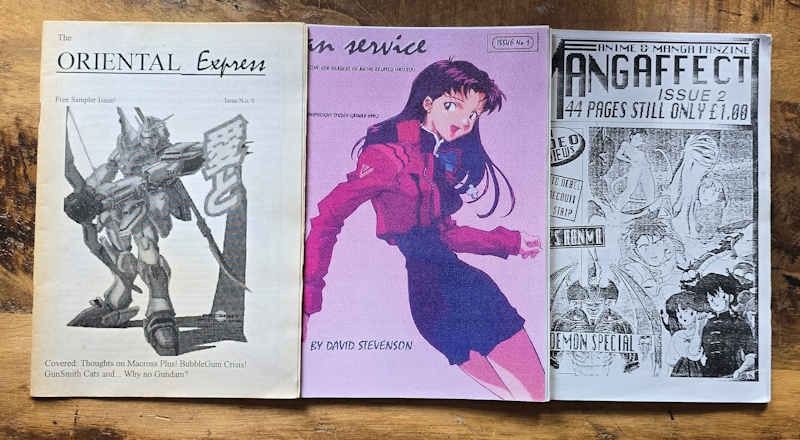
Early anime fandom was expressed on paper! I guess David Stevenson and I favoured the same font...
It's important to remember that, during the mid 90's, the very idea of Japanese animation was either abstract or seen as something threatening. The Times Culture supplement ran a cover called "Over Cute, Over Sexed and Over Here", an alarmist and lopsided piece that focussed on the excesses of anime at it's most extreme and ignoring the full width of genres it contained. Playing into the stereotype with Akira, Fist of the North Star and Venus Wars, all were marketed with visceral glee by Manga Entertainment. My hatred of the mainstream media's wilful ignorance (and often, outright racism) fuelled my passion for writing about the broader aspects of anime and manga.
Of course back then, news was scarce and updates weren't so immediate, so the whole site grew slowly, page by page - copy and paste the code, change the contents and the images, save the page with a new name, add it to all the menus, upload via FTP and repeat whenever something new came out. No content management systems then... When I wanted to change the website design, it meant copying and pasting all the changes to every. single. page. As you can imagine, wholesale redesigns were rare back then. When they did happen, it was a whole weekend of coding, graphical editing and quaffing coffee. Happy days!
Sadly the Wayback machine doesn't go past 2000, so looking for older versions of the site is a bit of a nightmare - I know I have some floppy disks around here somewhere with early versions of the site on, but it's funny how many design sensibilities of the time still informs a lot of the site's design philosophy today. Being limited by 28.8k modems, I had to ensure the graphical elements were highly optimised and used effectively - even now, outside of banners I stick to 800 pixel width images that are optimised .jpeg files to keep things efficient. Images also used to require editing with basic tools, with backgrounds removed through long hours of pixel-by-pixel editing. I am now deadly with a mouse.
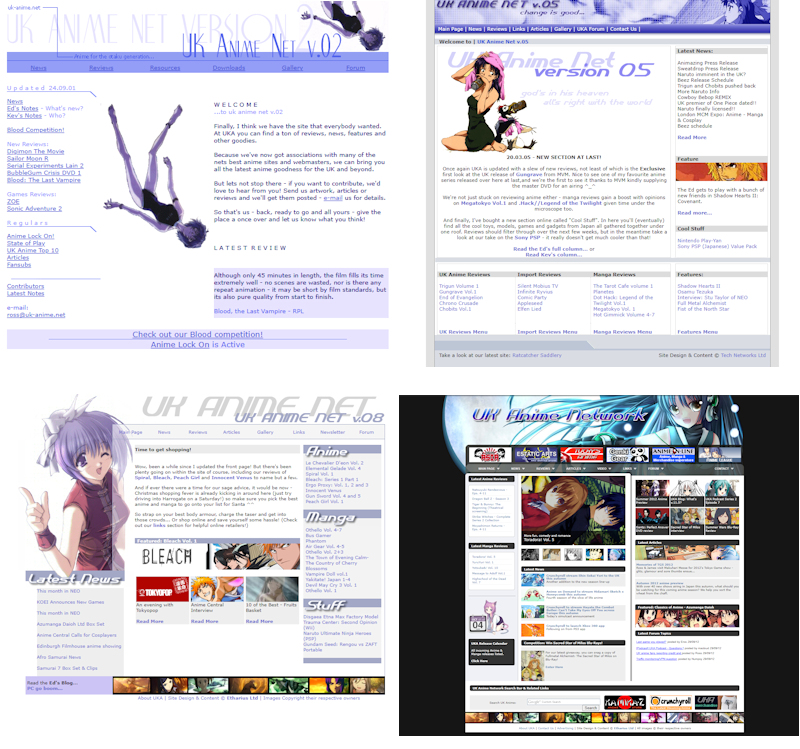
The many faces of UKA, 2001 - 2017 - much easier to do once I created my own Content Management System, which also powers some multi-national companies today.
When new companies started to emerge - Kiseki and Pioneer were the major new arrivals with the likes of East 2 West following on - they brought with them a gentler style of anime. Kiseki gave us popular Sci Fi of the time with Macross II, Pioneer bought the comedy with Tenchi Muyo, El Hazard and Moldiver, but even without them Manga Entertainment started to broaden its horizons with cult classics like Dangaioh. Even the Anime UK team headed by Helen McCarthy pitched in with a diabolical British dub of KO Century Beast Warriors - the whole industry felt like it was on an Indiana Jones style treasure-hunt for whatever titles could be found, released with increased regularity and I was there documenting all of it. I even wrote to Pioneer and others like ADV to get review tapes, which arrived on VHS regular as clockwork.
The site tootled along, rarely causing controversy but occasionally being infamous in the short term - my Rants column drew the ire of Manga Max when I criticised their obtuse review of a fanzine called Boiled Spoons that was so negative it broke their own publishing guidelines. My scathing (and played up for comedy) criticism had half the staff emailing me with vitriol, some of it so nonsensical it was actually laughable - "If I don't reply to a point in your correspondence it's because I agree with it or it is beneath me to reply". Well, that's clear as mud then. What a dummy. Only the author of the review seemed happy to discuss it calmly (despite trying to set me up into writing a column that would upset the fans - sorry, not that stupid).
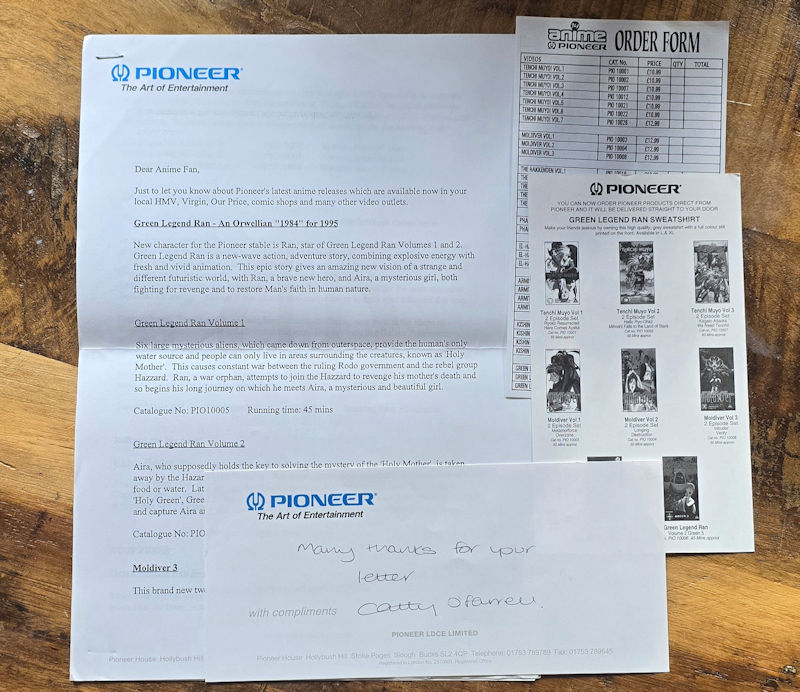
Before there was email, there was post... Early correspondence with a fledgling (and short lived) Pioneer Anime. I throw away nothing.
Back when anime was delivered on chunky VHS tapes (ask your parents), it was easy to keep up with - two episodes per tape, one tape per month and not many series running concurrently. Of course that seems ludicrous now, with entire seasons dropped at once, or the latest anime episodes simulcast with Japan, but back then it was all very basic - UKA became a good resource to find out what was out when, as I was on every distributors mailing and review list. It felt like a great privilege to be granted this level of access, decades before "influencer" became a thing. It felt small, friendly and communal, which was great for me since before I moved away from Oxfordshire we lived in a hamlet miles away from anything. I still had my friends at school and was able to drive at this stage, but time at home was pretty dull without a hobby. Writing was always mine and there are half-finished manuscripts across all sorts of media, including a few Bubblegum Crisis fanfics. And no, you can't read them...
Meanwhile, anime style reared its head elsewhere, and one of the standouts was British SNES magazine, Super Play, each cover beautifully illustrated by Wil Overton - I still have the postcards featuring some of his best safely stored away (see below) and a full set of the magazines, and seeing this friendly representation of Japanese culture on the newsagent shelves made it seem like anime was gaining traction. The magazine featured Japan-related content by Helen McCarthy (Anime World) and Peter Evans (Live from Hell City), both were hugely influential on my wider view of anime and the country of its birth. One day, I vowed, I would visit this mythical land! Alas that wouldn't happen for 20 years (though boy, did I make up for the wait!).
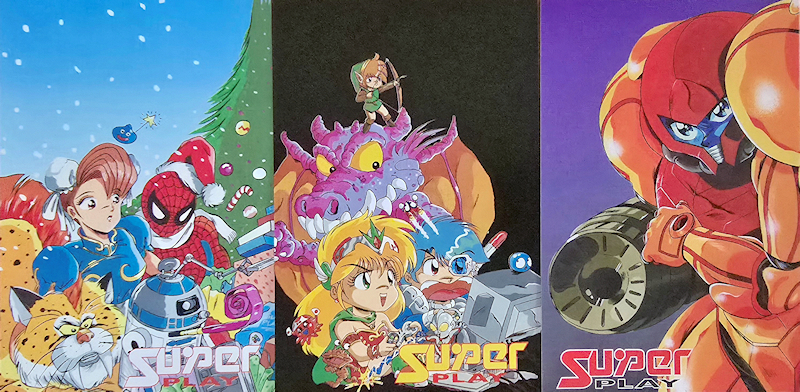
Super Play magazine introduced gamers to Japanese culture
Once conventions started to become a thing, I met other fans at events like Southampton's Minami Con and the site gained new writers - we've had a lot of people pass through here over the years, some staying for a few weeks to get that one article off their chest, others staying for years, but all drawn in by the love of anime and sharing it with others. There was always a core of older anime fans that had found a place in print or media, but I never felt a need to get involved directly - I never liked the politics or the cliques, so I've stayed out of them for the most part, content to enjoy the medium and keep it as a hobby. However, I was "known of" thanks to the website and usually had a warm reception - plus we had a small group of regular contributors now and we had a great time getting together among like-minded fans. The highlight was always perusing the dealers room for goodies long before you could just order online. Sadly the external drive that held all of my old convention photos died years ago (I had an early digital camera that shot 640 x 480 pixel images, way ahead of my time) but sadly both the camera and the drive are long gone.
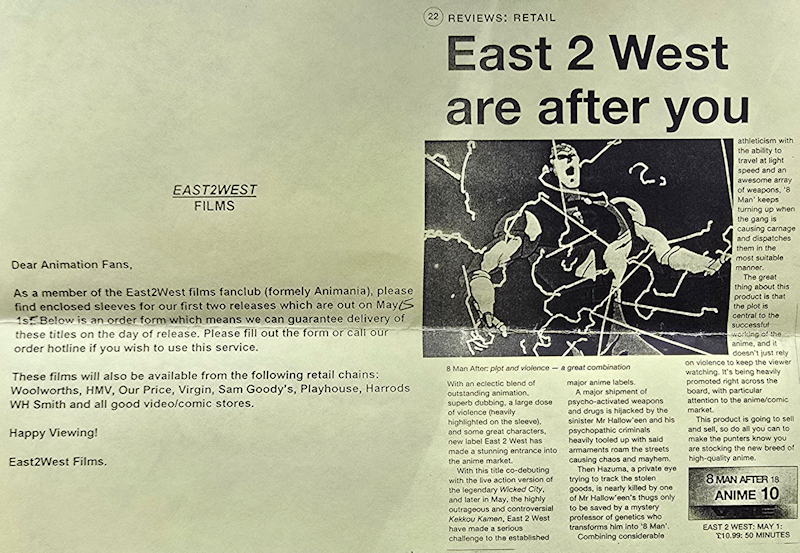
I can't work out if East 2 West are recruiting or in a queue - "East 2 West are after you"
I also found myself attending a local anime club (Yorkshire Area Team Anime, or Y.A.T.A) which met in Leeds every two weeks to screen fansubs in a pub lounge. Here I found gems like Berserk and Escaflowne, the latter of which had the last episode so worn down that it had degraded to black and white. Driving home from the club one night in my brand new Mini, I was asked at a set of traffic lights by two girls to give them a lift to a nightclub - Mini's were new and cool back then, I had one of the first - and so I obliged like a gentlemen, only to be told by the members at the next meeting that I'd been seen picking up two ladies of the night on my way home! Honestly I felt flattered they thought I needed two. Had I not been attending a funeral the next morning, I would have accepted their invitation to go in to the club with them - ah, to be young again!
It feels strange now, looking back, that a chance encounter with Ranma 1/2 redirected my life so comprehensively - I had the keys to another world and a little corner of the internet to talk about it that I called home. Humble beginnings, chance encounters and the passion of other fans formed friendships that would go on to create more connections even beyond those we could directly observe, a kind of magic in its own way that has seeded a new generation of anime fans and professionals.
Back then, we couldn't imagine anime going mainstream, it felt like such a niche culture, caged by negative press, that it never really stood a chance despite our collective best efforts. Little did we know.
In the next article, we'll look at how the anime boom of the 2000's changed everything.

Ross founded the UK Anime Network waaay back in 1995 and works in and around the anime world in his spare time. You can read his more personal articles on UKA's sister site, The Anime Independent.